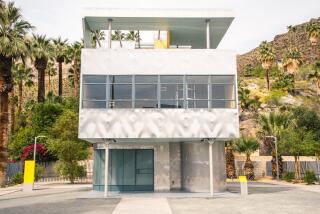An Architectâs High Style in Homes, Life
This Black History Month has prompted me to look again at some of the designs by the late Paul Williams, an exceptionally talented and successful architect.
Williams, who died in 1980, was perhaps best known as an architect to the rich and famous, having designed homes for such luminaries as Cary Grant, Tyrone Power, Frank Sinatra, Lucille Ball and Desi Arnaz, Danny Thomas and auto maker E. L. Cord.
His elegant, understated, spacious homes, ranging from neo-Colonial to Modern styles, are scattered in Hancock Park, Beverly Hills, Malibu, Pasadena, Palm Springs and, in particular, Lafayette Square, where he lived most of his life.
Among his more prominent commercial projects was the Music Corp. of America building, now housing Litton Industries, a relaxed Federal Revival-styled structure at Burton Way and Rexford Drive in Beverly Hills. It was completed in 1940.
Also in Beverly Hills, Williams, with John and Donald Parkinson, designed in 1936 the well-detailed, slick Moderne-styled Saks Fifth Avenue building at 9600 Wilshire Blvd.
A somewhat strained version of the neo-classical Modern style popular in the 1950s was Williamsâ design of the Los Angeles County Courthouse at the northwest corner of Hill and 1st streets downtown.
That Williams was black often came as a surprise to potential clients who only knew him by his work or through a recommendation, and sometimes he had to struggle mightily to win and hold a commission after an initial meeting.
According to his friends and family, a help was Williamsâ ability to sketch quickly and upside down, a talent that impressed potential clients sitting before him. He also knew how to involve the client in the design process by being a good listener and by exuding self-confidence.
Architectural photographer Julius Shulman remembers sitting in meetings during which an impeccably dressed Williams would draw out the stylistic preferences of clients. âHe had a way of putting the clientâs needs first and then designing a house around them that was a gift,â Shulman said.
That Williams was black also no doubt surprised members of the architectural profession, which when Williams began practicing in the 1920s was known as a âgentlemenâsâ profession and not particularly open or cordial to minorities.
With few exceptions, commissions were given out on the basis of social connections--to friends and acquaintances from colleges, country clubs and churches. To a lesser degree, political connections also helped.
âWilliams . . . was unique, especially considering his time and place,â commented Robert Kennard, who was a friend and colleague and himself a black architect of note. âHe had good contacts and made the most of them. He also was a Republican, and that served him well--especially in his later years in obtaining public contracts.â
Kennard added that public contracts are still what most minority architects depend on for work. Though Kennard said it is not as overt as in the past, private commissions to a large degree are still handed out on the basis of social contacts.
(Among Kennardâs more prominent designs are the medical educational building at 1621 East 120th St. on the edge of Compton and the Carson municipal civic center. He also designed the parking structures in the recent recasting and expansion of LAX.)
âWhere Paul was quite fortunate was that his first jobs were private houses for some very prominent people,â Kennard said.
The house that launched Williamsâ career was a mansion he designed in 1930 for Cord--a commission, he said in subsequent interviews, that he got by being able to produce preliminary plans for the auto maker within a day after viewing the 10-acre site on North Hillcrest Road in Beverly Hills. The plans called for a 30-room red neo-Colonial brick mansion and an 18-car garage.
The house and garage were demolished in the early 1970s and the land subdivided into nine building sites.
Still standing and representative of the relaxed Modern style Williams perfected in the â50s are three houses bordering St. Charles Place in Lafayette Square, a tree-lined oasis of gracious homes west of Crenshaw Boulevard between Venice and Washington boulevards.
In respect for the privacy of the owners, including Williamsâ widow, those interested in the exact location of the houses are asked to contact the Lafayette Square Assn. at (213) 732-3587. A map of the neighborhood identifying houses of historic significance, including Williamsâ, is available from the Los Angeles Conservancy, (213) 623-CITY.
More to Read
The biggest entertainment stories
Get our big stories about Hollywood, film, television, music, arts, culture and more right in your inbox as soon as they publish.
You may occasionally receive promotional content from the Los Angeles Times.










